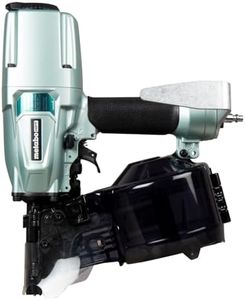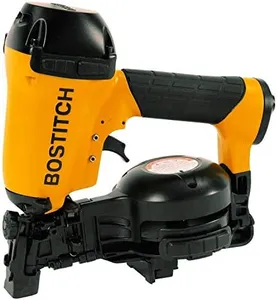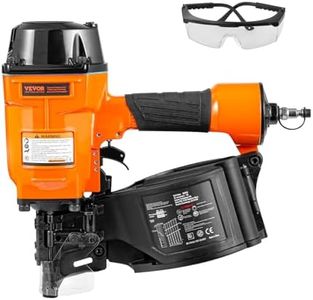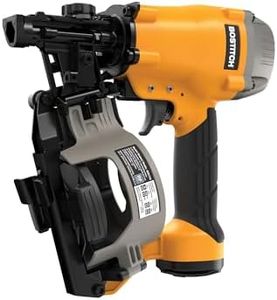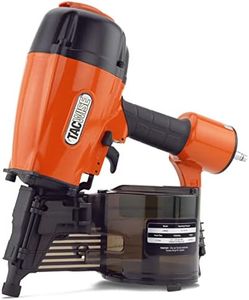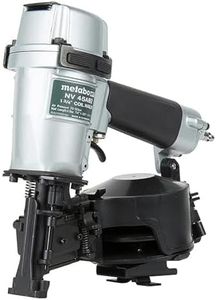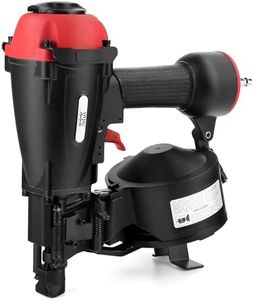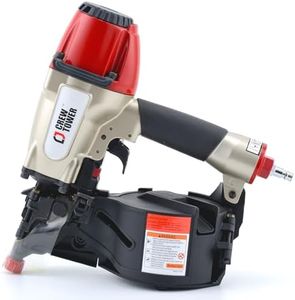We Use CookiesWe use cookies to enhance the security, performance,
functionality and for analytical and promotional activities. By continuing to browse this site you
are agreeing to our privacy policy
10 Best Coil Nailers
From leading brands and best sellers available on the web.By clicking on a link to a third party's website, log data is shared with that third party.
Buying Guide for the Best Coil Nailers
When it comes to choosing a coil nailer, it's important to consider the kind of projects you'll be working on, the frequency of use, and the materials you'll be nailing. Coil nailers are a popular choice in construction and carpentry because they hold more nails and require less frequent reloading than stick nailers. Getting the right coil nailer ensures smoother, safer, and more efficient work, helping you avoid jams and downtime. To select the best fit for you, get familiar with the main specifications that influence performance and ease of use.Nail Size RangeNail size range refers to the shortest and longest nails the coil nailer can handle. This is important because different jobs require different nail lengths. Smaller nails, usually in the 1 to 1.25 inch range, are suited for lighter applications like attaching thin boards or shingles, while larger nails, ranging up to 2.5 or even 3.5 inches, are needed for heavy-duty framing or decking. When picking a coil nailer, think about the materials and types of projects you’ll work on most. Choose a model whose nail size range matches your needs; if you are doing varied tasks, a broader range offers more flexibility.
Magazine CapacityMagazine capacity tells you how many nails the tool can hold at one time. This matters because a larger capacity means fewer reloads, which boosts productivity, especially for bigger projects. Capacities usually range from about 100 to over 300 nails. If you often work on large tasks where speed matters and reloading interruptions are a hassle, opt for a higher capacity. For smaller or occasional projects, a lower capacity may be lighter and more comfortable.
Operating PressureOperating pressure is the air pressure needed to power the coil nailer, typically measured in PSI (pounds per square inch). Most models require an air compressor within a certain pressure range, often between 70 to 120 PSI. Adequate pressure is crucial for driving nails consistently and completely into materials. Lower PSI tools are fine for lighter jobs and thin materials, while higher PSI is better for tough, thick woods or framing. Make sure the nailer you select matches the compressor you plan to use, and suits the types of materials and work intensity you expect.
WeightThe weight of a coil nailer affects how long you can use it comfortably. Lighter nailers are easier to handle, especially if you’re working overhead or for extended periods. Heavier models might offer more durability or power, but can cause fatigue if used for a long time. If your typical tasks involve lots of movement or awkward angles, prioritize lighter models, while stationary or heavy-duty work may allow for a heavier, sturdier nailer.
Depth AdjustmentDepth adjustment allows you to control how deep the nail goes into the material. This is important for different types of wood and the finish you want. A nail set too deep can weaken the joint, while one sticking out can be a safety risk and look unprofessional. Look for a model with an easy and precise depth adjustment, especially if you work with a variety of materials. This feature lets you quickly adapt to each job without extra tools.
Jam Clearing MechanismJam clearing is about how easily you can fix a jammed nail inside the tool. Jams are common in frequent or heavy-duty use, and a tool-free or simple mechanism makes it quick to fix, reducing downtime. If you know you’ll be nailing a lot or working under time pressure, prioritize models with convenient jam clearing. Occasional users may not mind more basic solutions.
Ergonomic DesignErgonomic design considers the handle shape, grip comfort, and trigger placement. These factors are important for reducing hand strain and increasing accuracy. If you plan to use your coil nailer frequently or for long periods, look for features like cushioned handles, balanced weight, and easy-to-reach controls to prevent fatigue and injuries.

